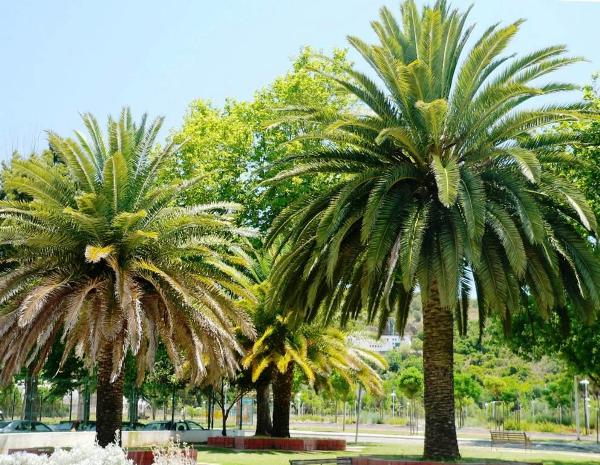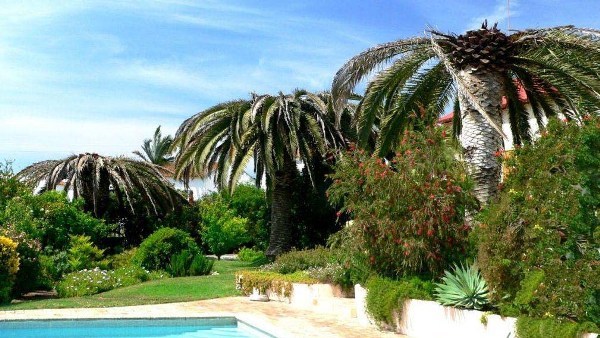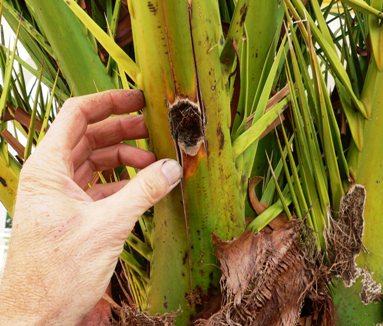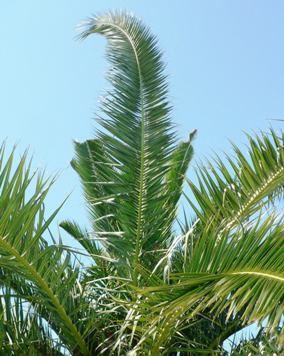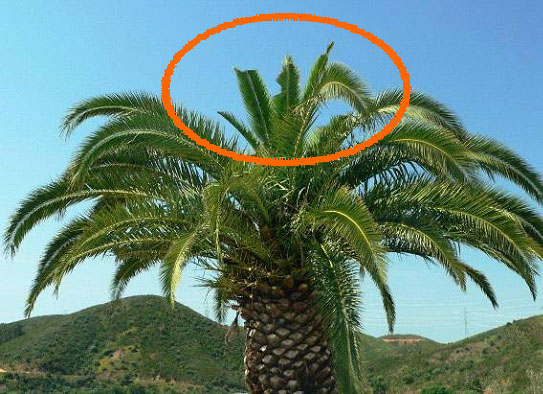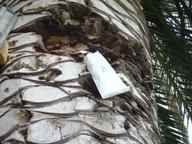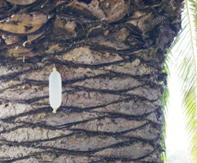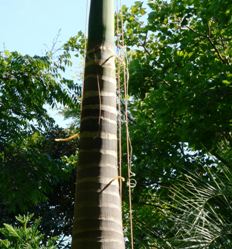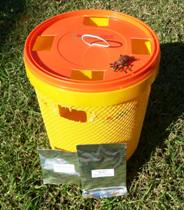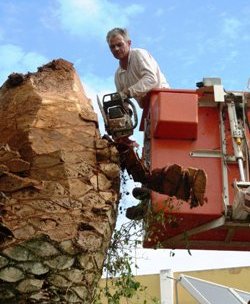|
|||||||||||||
| The
Red Palm
Weevil A serious threat to the Portuguese landscape |
|||||||||||||
|
|
|||||||||||||
| Introduction.
In
May 2008, Manuel Rodrigues
of the Parks and Landscaping
division
in
Silves,
spent half a
day showing the author the damage
caused
in
that concelho
by the
“Gorgulho Vermelho” or
Red Palm weevil.
This
article is the
result of
research
undertaken
since that
experience.
Almost
nothing has been
done to warn the
public
of a serious threat and
how to tackle
it, past
and present
official
policies must change
radically and much needs
to be learnt about
controlling the
insect
sustainably. From Porto on the northern coast to the Algarve in the south, palm trees, and particularly the Canary Island Date, Phœnix canariensis, a sturdy, showy plant which once established could almost be forgotten about, constitute an important part of Portugal's landscape. (Figure 1)
With
the arrival of the Red Palm
Weevil,
Rhynchophorus
ferrugineus,
in the
Algarve less than
two years ago, that has begun to
change.
In the first eight months
of 2008 alone, over
10,000 palm trees
have
been destroyed
because
of the weevil
just in
neighbouring
Andalucía.
This
should warn us
about what Portugal can
expect. Since
then
the insect, which
almost certainly
entered
the country in
trees
imported from
Egypt or
Spain early
last year,
has
probably penetrated
hundreds of palms in
the
Algarve and scores
have already been
killed.
(Figure
2) The problem is still new to Portugal but it is just another stage in a process which began in the 1980s when the beetle, native to Southeast Asia and Melanesia, started to spread west and north. Moreover, this new arrival in the Algarve is only a small part of a much larger picture the naturalist E.O. Wilson recognised long ago as a major challenge of our age - the invasion of exotic species. Portugal has certainly not been exempted and most of us would be astonished at how much foreign flora and fauna has become naturalised here. On its journey, the weevil has attacked coconut palms in India and ravaged date groves across the Gulf and parts of North Africa before spreading to much of the remaining Mediterranean.
As well as the common Agave
and sugarcane, over 30 palm species
including
both of
Europe’s two native palms are known
victims.
But the
insect is particularly
fond of date
palms and, for reasons
which remain a mystery,
it is especially drawn
to males
of the
Canary Island
Date. According to
a knowledgeable
Spanish source, about
80% of trees lost to the
weevil there
are
Canary
males. This
is bad news for
Portugal.
Although
it
has no
harvestable
crop
(apart
from a little
‘honey’ tapping in its habitat),
this
handsome
tree is
the
most visible and significant palm in the
local
landscape and it
has been extensively
planted,
especially
in the
Algarve, in
parks,
hotels, villa developments
and private
gardens
as a
beckoning
suggestion that the tropics aren’t
so
far
away. Much
of
Portugal will look
very
different without
its
most common palms
and
there is every
indication we will
lose
these exotics as
well as
true dates and
Washingtonias in
addition to other more
unusual members of the
family if serious,
national and
community-wide
measures
are not
taken. Like every beetle, the Palm Weevil undergoes several remarkably
different stages during its roughly 4-month-long life cycle
which begins on breaking out of an egg similar to a small polished
rice grain and culminates in an extraordinary metamorphosis
from almost featureless grub into a complex and conspicuous
adult. (Figures 3 & 4) Although the
insect can be quite large with an adult body 3-4cm long and
a larva of 5cm, it is rarely seen because almost all its life
is spent hidden among frond bases or within the trunk itself.
On
emerging from their fibrous
cocoons -
the
second
insect (head
visible)
in Figure 3 - adults usually
remain on the same host. But they can
fly several kilometres
to locate another
suitable tree where
males produce a highly
specific scent
(pheromone) to attract females
as well as
males.
If the palm is
injured,
because of burrowing insects or
freshly
cut fronds, for
example, this
attractiveness
is
enhanced by
a kairomone, another smell
emitted from the tree’s wounds.
After
mating the female
will lay 200 to over 300 eggs which hatch
within a week and drill into the
tree.
This is the stage
when
almost all the
damage
occurs. The
hatchlings, only
a few
millimetres
in length at
birth, enter the
palm, feed on
its
internal tissues, grow
dramatically and in
the
course of
about 4-12 weeks turn into
5cm-long larvæ before emerging to
pupate and
repeat the
cycle. Every stage of the weevil
can be
present at the
same time on the same
tree. For
all the damage already inflicted across much of the Old World
by an almost invisible, seemingly unstoppable insect, several
protective treatments exist and are definitely effective.
The first, essential, step is to identify signs of attack as
soon as possible. Holes the thickness of a finger, Figure
5, from which the grubs emerged can be found anywhere on
the trunk, but usually near the crown, or in frond bases.
There is sometimes an unpleasant vomit-like odour of rotting
vegetation and brown ooze from the wounds or trunk surface.
It should be noted that these injuries expose victims to potentially-lethal
fungi. But the most obvious signal is one or more mutilated
leaves or even a broken frond emerging at the top and centre
of a frequently asymmetrical or incomplete crown. (Figures
6 & 7)
Gnawing
rats can cause similar if tattier frond damage. The contrastingly
clean-cut weevil incisions may remind observant, well-travelled
readers of Rhinoceros beetle damage to coconuts. (With
a little continuing help from the authorities and global warming,
an issue with which they have been equally remiss, this is a
new exotic we can look forward to.) N.B. In rare
cases, larval damage of the Canary Date is confined to areas
beneath &/or around the growing tip and no alerting
leaf damage will appear. But warning signs such as displayed
in Figure 7 are usual although they may be more
concealed within denser healthy fronds than illustrated here.
Check carefully. By the time these broken stems or incomplete
leaflets which look as if they’ve been trimmed
with scissors
appear,
internal
cavities may
well be extensive.
But a
weevil-damaged
tree is by no means a
doomed tree. As
severely
fire- or
lightning- injured palms in
the
tropics attest, half
a trunk may be lost and
yet sufficient vascular
bundles remain
(since
this circulatory
system
occupies the
whole of the trunk,
not
just its exterior as with regular trees),
to
sustain healthy
crowns. Thus the only
standing survivors of burned tropical
forest
are usually palm
trees because they can incur considerable
damage and still
survive. If one is vigilant
and acts quickly,
major
losses will be
avoided
and in warm weather
recuperation
can be
quick. It should
not be assumed,
however,
that
because the weevil remains
undetected in an
area or
even because
a garden is
isolated that
trees are safe. Monitor
them! What
should be done as soon as
damage
is
detected? Currently,
two types of
insecticide
must be applied in different ways to
affected
trees.
Contact insecticides
(such as
Diazinon)
are sprayed
against
insects, eggs and pupæ that the
chemical
reaches
on the
surface. And, most
important, systemic
insecticides (like
Imidacloprid or
Tiametoxan) which plants
absorb and
incorporate
in their
tissues (or
system) to kill
whatever
eats them are
injected
into the
trunk to tackle concealed
larvæ. This
involves
drilling the trunk and
inserting a tube
with a
small bladder
attached
that squeezes
insecticide into
the
tree.
Four
such
injections are
normal with a Canary
Date. (Figures
8-11)
Small or contained palms can incorporate sufficient systemic agent through their roots and may simply be watered with the product. But adequate uptake is unlikely with the larger specimens preferred by the weevil. And because of the volumes required to treat mature trees and the risk of groundwater contamination systemic irrigation is limited in Europe to two applications annually. Injections, therefore, are a far more efficient and environmentally sound method. Nevertheless, not all larvæ may be killed with the first injections. And the chemicals, like antibiotics in our bodies, are gradually metabolised. So for maximum security the treatment should be repeated at least a second time 2-3 months later. Especially
for big trees, these
procedures are onerous and
can be
expensive -
in
areas of
extreme
infestation eleven sprays
and injections are recommended yearly
costing
up to 450€ for a
single tree. But
in
most cases larvæ can
be
eliminated with one or
certainly
two injection/spray
treatments. These
will cost about
75€ for
a single tree’s
dual
treatment or ~65€ each
for several
palms.
To the
person who buys a few plants
and some
fertiliser
occasionally, these
figures may
appear
considerable.
But
to
the home-owner who appreciates the
landscaping
merits
of a large
specimen, or
merely
recognises its
contribution to
a
property’s value, they will
be worth it.
And
to the
hotelier,
developer or
local
authority aware of
what it will
cost to
remove, destroy and then replace large
palms,
the response
should be obvious: save
your investment.
(Figure
12.) Injection/spray treatment can, of course, serve as protection
for healthy plants as well
as a
cure for
infested ones. But
in
the author’s opinion
injections are of
questionable value
in
moderately
affected
areas for healthy
specimens which don’t
need unnecessary
piercing any more than
we
do. In almost
all
cases sprays will be
adequate and last several
months in
dry
weather.
Again,
look regularly
and carefully for signs
of damage on
emerging
fronds and act without
delay. This
applies no less even
after
treatment.
In exposed areas
Canary Dates
in
particular, and
especially males (which
bear no
fruit), will remain vulnerable if
sprays are
discontinued
and traps, described
below, are absent or not
maintained. Two additional, easier measures can deter (further) attack even of unsprayed trees. The first of these, the weevil trap is critical. It is much less costly than sprays and injections and has proved invaluable in campaigns against the insect throughout its range. As noted earlier, adults are drawn to palms by smell. The trap is essentially like a large bucket with side openings and a top cover from which scent lures are hung. Two models are available in some nurseries: a white bucket with pheromone and insecticide packets (20€), and a yellow one with pheromone and kairomone packets (ca 30€), Figure 13. The packets should be opened to release their smells and lure beetles to be killed by the insecticide or drowned in not less than 5-10cm of water at the bottom of the yellow trap. The pheromone and kairomone packets last three months in shaded areas and must then be replaced. (~17.50€ the pair.) The white trap’s insecticide may be inappropriate if hungry children are around and the absence of a kairomone lure reduces its effectiveness. The addition of water, always at least 10cm below the rim, and fermenting fruit such as apple, quince, banana or longer-lasting sugarcane and shredded palm, can compensate for this. Indeed, some consider these materials better than the synthetic attractant. Adopting these measures as well as treating infested palms will not only save your trees and avoid costly removal (Figure 14) but help contain the weevil’s spread to others. Trapping is a vital tool against the weevil and is strongly encouraged at the base of affected palms in order to contain an infestation; or at a distance from vulnerable trees in areas where some palms have been attacked. It will also afford
protection
if old but
still green fronds are
cut, reduce the weevil
population and related
fungal infection,
draw
roaming
adults away from
clean trees and monitor how common
the insects
are.
But traps are not
recommended in
safe
areas where
they
will only
expedite
the insect’s arrival.
(One
entomologist
consulted
dissents, believing traps should
be
placed to detect
danger
right away.)
An
added precaution,
everywhere, is not to
cut
lower fronds flush with the trunk.
Fronds should either be
left to dry naturally
before sawing
off or, if
this proves
too
untidy, they should be cut a
metre
or more
from the
trunk
before removal of the spiky bases once
dry. (Figure
15.)
Helpfully, date petioles
unlike those of other
palms are more easily
sawn or shredded
when
dry. Both the insecticides and the traps definitely work and
should
be employed
immediately where
needed. But
insecticides
are not
the
ultimate
solution.
They are poisons, killing
good
and bad creatures; so targeted injections
are preferable
to
spreading
sprays. Insecticides
can
also be expensive
and
they promote pest
resistance.
Several sustainable
alternative strategies
are
successful in the laboratory.
Pathogenic
fungi and
nematodes as well as gamma radiation can
all
overcome the
weevil. Pheromone
disruptors or
blockers
to confuse an insect’s
smell-based orientation
as well as the
release
of sterile
adults have
been
successful with other pests.
But
effectiveness of these measures in field
conditions against
the
weevil remains
unsatisfactory.
Effectiveness in official circles, as already noted, is
equally
disappointing. The
Red Palm
Weevil reached
Europe 15 years
ago. Yet
it took
Brussels until
May 2007 finally to adopt
“emergency
measures” to
prevent its
introduction into the
Community.
By that
time,
generations of the
bug had been active in every
major EU
Mediterranean
country for
years. What is
needed
(and the NGO
Acção
Ambiental has
lobbied
for) is a
Community website
to
distribute accurate information and furnish
expert advice
in
several
major
languages
as
well as a dramatic
reduction in
costs of
materials - we can pay
30€ or more for a
weevil
trap which in India sells for 3$ and in
Jordan
1€.
Substantial funding is
similarly
required for
research into
sustainable
alternatives
to
help not just Community members
but farmers
in a score
of other
countries. (An
American
firm told the
author an olfatic
disruptor could probably be
developed
for
about
750,000$. A simple
and effective larva
detector could be far
less.) The Red Palm Weevil has spread with the assistance of
incompetent
governments
from Asia to Africa
and
because of the
transport
of infested
(principally date)
palms. The insect’s
reclusive
ways, the need
for acoustic
equipment and
skilled
interpretation
to detect active larvæ,
the dilatory display of
damage and the
cost of
current
treatment, well
beyond
the reach of many in
its path to Europe,
have
also militated in its
favour.
The
danger
presented by
the
weevil will only be overcome
by
concerted
efforts in
all areas
where it is found. It is
still
new in Portugal
and we have an
opportunity to
learn
from
others’
mistakes. We must
not waste
it. Algarve, 30 August 2008. Comments
& criticism – info@AAmbiental.org |
